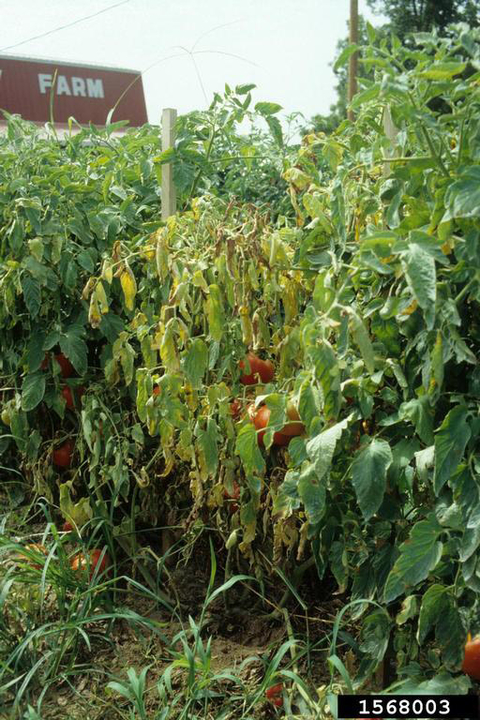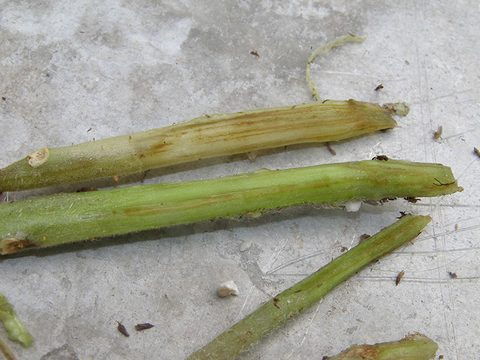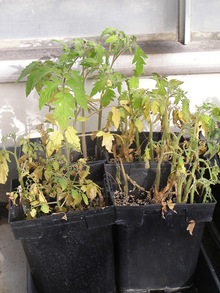Quick facts
- Susceptible crops include tomato, eggplant and pepper.
- The entire plant turns yellow and wilts. Occasionally the leaves will turn brown.
- The fungus Fusarium oxysporum f. sp. Lycopersici causes fusarium wilt and infects solanaceous crops and weeds (such as pigweed, mallow, and crabgrass).
- The fungus can be introduced on infected transplants or spread on equipment contaminated with infested soil.
- There are many varieties of host plants with resistance to Fusarium wilt.
How to tell fusarium apart from other plant issues
- Initially, plants wilt during the hottest part of the day and recover at night.
- Leaves turn yellow, but the yellowing is not uniform. Sometimes leaflets turn yellow on one side of the plant, or even just leaflets on one half of a compound leaf.
- The entire plant soon turns yellow and wilts. Browning of leaves occurs rarely.
- Peeling the epidermis (outer tissue layer) off the lower stem will reveal dark red and brown discolored vascular tissue.
- Confirm diagnosis by sending a plant sample to the University of Minnesota Plant Diagnostic Clinic, as this disease is easily confused with Verticillium wilt.
Biology
- Fusarium wilt is caused by the fungus Fusarium oxysporum f. sp. lycopersici, which has three races; race 1, race 2 and race 3.
- Fusarium wilt affects tomato, eggplant and pepper. It can also survive on weeds such as pigweed, mallow and crabgrass.
- The fungus thrives in warmer weather (optimal soil temp 82°F) and is more severe in acidic soil.
- The pathogen most often enters through root wounds caused by cultivation or by nematode feeding.
- Fusarium wilt can be seed borne, but it is rare in commercial seed. The fungus can be introduced on infected transplants or spread on equipment contaminated with infested soil.
- The pathogen moves up the plant through the vascular system.
- Only one infection cycle occurs each growing season; once a plant is infected, it usually will not spread to another plant in the same growing season.
- The fungus can survive as chlamydospores (fungal resting structure) for many years in the soil or in plant debris.
- Long distance dispersal by air borne spores only occurs very rarely.
Managing fusarium wilt in the home garden
There are many varieties with resistance to Fusarium wilt. Fusarium oxysporum f. sp. lycopersici has three races; race 1, race 2, and race 3. Some tomato varieties may be resistant to one race, yet completely susceptible to another. Most seed catalogues indicate resistance to Fusarium and which of the 3 races the variety is resistant to. The only way to know which race is present in your garden is to submit a sample to the University of Minnesota Plant Diagnostic Clinic.The fungal pathogen may be present in resistant plants even if they do not show any symptoms. For this reason, planting resistant varieties should not be considered a rotation away from susceptible tomatoes.
- Purchase disease free seed and transplants from a reliable supplier.
- Clean soil and plant debris off all equipment each year, and every time you work with infected plants.
- Completely remove infected plants. Burn or bury plants in an area that will not be used for solanaceous crops.
- Rotate away from susceptible crops for 3-5+ years will reduce disease pressure, but careful weed management must be done during this period.
- Avoid excessive nitrogen as it will encourage disease.
- In acidic soils, raising the soil pH to 7 can help to control disease.
There are no chemical options available for fusarium wilt.
Managing fusarium wilt on the farm
There are many varieties with resistance to Fusarium wilt. Fusarium oxysporum f. sp. lycopersici has three races; race 1, race 2, and race 3. Some tomato varieties may be resistant to one race, yet completely susceptible to another. Most seed catalogues indicate resistance to Fusarium and which of the 3 races the variety is resistant to. The only way to know which race is present in your garden is to submit a sample to the University of Minnesota Plant Diagnostic Clinic.The fungal pathogen may be present in resistant plants even if they do not show any symptoms. For this reason, planting resistant varieties should not be considered a rotation away from susceptible tomatoes.
Varieties without resistance can be grafted onto disease resistant root stock.
- Purchase disease free seed and transplants from a reliable supplier.
- Clean soil and plant debris off all equipment prior to moving to a new field.
- Completely remove infected plants. Burn or bury plants in an area that will not be used for solanaceous crops.
- Rotation away from susceptible crops for 3-5+ years will reduce disease, but careful weed management must be done during this period.
- Avoid excessive nitrogen as it will encourage disease.
- Use of calcium nitrate fertilizer instead of ammonium nitrate can reduce Fusarium disease severity in some soils.
- In acidic soils, raising the soil pH to 7 can help to control disease.
There are currently no pesticides that provide control of Fusarium wilt.
Reviewed in 2021




